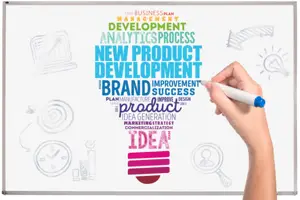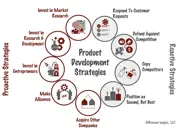Product Development Strategy: Ultimate Guide
How can you enhance your development efforts to yield a more favorable return on both your time and investment? In this comprehensive guide, we'll assist you in pinpointing the most suitable product development strategy to align with your growth objectives and beyond.
Join us on a journey with Aniday as we explore the definition of a Product Development Strategy, its advantages, and some of the prevailing strategies currently in the market!

What is a Product Development Strategy?
Product development strategy encompasses the approaches and activities employed to introduce new products to the market or adapt existing ones to foster fresh business opportunities.
The process of creating a product entails multiple phases, spanning from ideation to customer distribution. Each of these stages demands a well-planned strategy to achieve success and drive revenue for the business.
Product Development Stages
Product development encompasses the entire innovation process, from concept generation to product delivery to customers. When revamping an existing product to generate renewed interest, these stages serve as checkpoints to assess the potential success of the modifications in driving business. The seven stages of product development are:
-
Idea Generation: This phase involves brainstorming for new product concepts and ways to enhance existing ones.
-
Editing and Selection: The product development team identifies the most promising ideas for success in the market.
-
Prototype Development: Upon idea selection, the company creates a prototype or preliminary version of the proposed product to assess its functionality and appeal to the target audience.
-
Analysis: In this stage, the company conducts market research and evaluates potential product issues.
-
Product Development: After integrating insights from the analysis into the prototype, the final product is crafted.
-
Market Testing: Before a broader release, products are often introduced to a smaller market or focus group to gather customer feedback and assess marketing effectiveness.
-
Commercialization: The ultimate stage of product development involves fine-tuning the product based on market testing and releasing it to the full market.

The importance of Product Development Strategy
Product development strategy holds significance due to its reliance on market research to craft a blueprint for effective product sales. A comprehensive strategy entails the methodologies and approaches to be employed at every phase of product development.
This enables you to navigate challenges and concentrate on the most effective tactics, paving the way for product enhancement and business expansion. Furthermore, strategizing product development facilitates product adjustments and overall business growth.
In addition to the aforementioned benefits, a product development strategy serves multiple other purposes:
-
Risk Mitigation: Your product development strategy leverages existing market research, mitigating uncertainty during the product ideation and conception phases. This ensures a thorough understanding of market needs at each development stage. As your research continues or your company expands, your strategy can evolve to yield optimal outcomes.
-
Agility in Response: To maintain competitiveness, your products and services must swiftly adapt to market changes. A product development strategy assesses your product's success, enabling you to monitor growth progress. When adjustments or changes are needed, you can promptly amend your development strategy or adopt a new one tailored to the new circumstances.
-
Identifying Under-Performing Products: Gathering feedback on your product's development journey empowers you to make timely decisions regarding underperforming offerings. This allows for efficient resource reallocation, optimizing the allocation of time and funds.
-
Enhanced Development Efficiency: A product development strategy provides a clear overarching direction, enabling development team managers to guide cross-functional teams toward priorities that align with the ultimate goal. Enhanced product development efficiency has a cascading impact on sales generation.
-
Proactive vs. Reactive Strategies: It's crucial to consider the distinction between proactive and reactive strategies. Proactive strategies involve upfront planning and trend prediction, while reactive strategies respond to market dynamics and adapt accordingly. Each approach serves distinct purposes in the ever-evolving business landscape.
Examples of Product Development strategies
While some companies may concentrate on modifying their existing products, others prioritize innovation. Regardless of the approach, both forms of product development demand a well-defined strategy for successful implementation.
Here are several effective product development strategies for product introduction and maintaining competitiveness within your market.
Revise an Existing Product
Refreshing an existing product with minor updates can motivate customers to opt for an upgrade. Concentrating marketing efforts on these enhancements encourages customers to explore the new version. This strategy entails identifying areas for improvement based on customer preferences.
For example, Apple is renowned for generating excitement with its annual iPhone launches, featuring larger screens, enhanced cameras, and the incorporation of additional functionalities.

Enhance Product Value
Engage customers by augmenting product value. This can be achieved by offering increased quantities, adding customer support, or introducing premium features. The added benefits attract new customers and encourage repeat purchases among existing ones.
As an instance, IKEA has gained recognition for its reliable supply of affordable, durable furniture. The company's ability to expand is facilitated by its diverse range of designs, providing customers with various design options.

Provide Trials
Offering a free or cost-effective sample version of your product can sway potential customers to give it a try. This method relies on the assumption that the quality of the product will lead trial users to purchase the full version. Trials demonstrate the broader benefits of your products.

Specialize and Customize
Customization and specialization appeal to customers seeking unique, tailored solutions. Allowing customers to personalize your product to their needs and lifestyle can set it apart from generic alternatives.
An example from Nutella, they further enhanced their marketing approach by introducing customization, enabling customers to personalize their jar with their name.

Create Package Deals
Boost sales by crafting package deals that expose customers to various product assortments, solving diverse problems for the customer. These deals can introduce customers to complementary products they might not have considered otherwise.

Introduce New Products
Expanding your product line can involve creating new products that cater to your target market. New products should complement, not replace, existing offerings, encouraging customers to explore a range of your products.

Adapt Ideas
Flexibility is key; if one product idea isn't resonating with the market, pivot and invest resources in exploring market demands. This adaptability helps you remain responsive to customer needs.
For example, Unilever adapts to growing needs for vegan product.

Explore New Markets
Consider introducing existing products to new markets or demographics. This could entail targeting businesses instead of individual consumers, appealing to different age groups, or expanding your product's geographic reach.
Example of Starbuck’s product when entering Japanese market.

Conclusion
To ensure coherence in your product development strategy, it's vital to set clear boundaries that align with your vision for success. As you progress, you may encounter instances where initial assumptions no longer hold true. In such cases, take a step back, evaluate, adapt, and iterate as needed. Aniday hopes this article has offered you an overview about product development strategy and how to apply it to your business. Good luck!
Aniday's HR Services
Headhunting Service
Find and recruit quality candidates in just 1 week! Supported by 40,000 experienced headhunters in IT, Finance, Marketing… capable of recruiting in any region.
Headhunting Service ➔Employer of Record (EOR) Service
On behalf of your business, we recruit employees and handle payroll without the need to establish a company in markets such as Vietnam, Singapore, Malaysia, India, Indonesia…
Employer of Record (EOR) Service ➔
